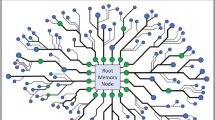Abstract
This article proposes a memory retention strategy in a knowledge network structure in order to make a more efficient intelligent system. The structure and management strategy of the memory have a great influence on the efficiency of the system. In this approach, the concept of neutral energy is introduced, which is used to represent the state of the knowledge node. The energy value of the node was designed to manage the memory retention and recall process in a brain-inspired system. This strategy was applied to a virtual memory and tested with sample data.
Similar content being viewed by others
Explore related subjects
Discover the latest articles, news and stories from top researchers in related subjects.References
Schacter DL, Scarry E (2000) Memory, brain, and belief. Harvard University Press, Cambridge, London
Mitra S, Acharya T (2003) Data mining multimedia, soft computing and bioinformatics. Wiley Interscience, New York
Cloete I, Zurada KM (2003) Knowledge-based neuro-computing. MIT, Cambridge
Shim J (2008) Personal knowledge network reconfiguration based on brain-like function using self-type matching strategy. In: Intelligent data engineering and automated learning-IDEAL 2008, Springer, Berlin, Heidelberg, pp 314–320
Shim J (2008) A design of brain sensory ensemble structure for intelligent system. Proceedings of ICCAS 2008, ICROS, Korea
Author information
Authors and Affiliations
Corresponding author
Additional information
This work was presented in part at the 14th International Symposium on Artificial Life and Robotics, Oita, Japan, February 5–7, 2009
About this article
Cite this article
Shim, J. Memory retention process by balancing the neutral energy point in a brain-inspired system. Artif Life Robotics 14, 535–538 (2009). https://doi.org/10.1007/s10015-009-0738-2
Received:
Accepted:
Published:
Issue Date:
DOI: https://doi.org/10.1007/s10015-009-0738-2




